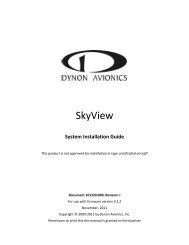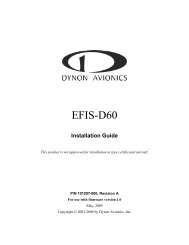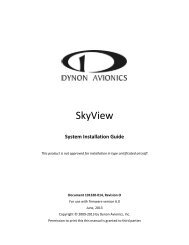EFIS-D100 Installation Guide - Dynon Avionics
EFIS-D100 Installation Guide - Dynon Avionics
EFIS-D100 Installation Guide - Dynon Avionics
Create successful ePaper yourself
Turn your PDF publications into a flip-book with our unique Google optimized e-Paper software.
AP<br />
ROLL/PITCH<br />
SERVO<br />
<br />
<br />
DSAB Configuration<br />
Roll Servo and Pitch Servo functions are automatically detected and<br />
assigned during Autopilot Servo Calibration process. See: <strong>EFIS</strong> > SETUP<br />
> AP > SERVO CALIB.<br />
More than two SV32s or SV42s is not a supported configuration.<br />
If the configuration process could not automatically assign the EMS and OAT roles (because<br />
there are 2 or more of either type found on the network), it prompts you to assign each of them to<br />
the instrument of your choice. It then presents a list of all instruments on the network capable of<br />
being assigned each role. Use the DOWN▼ and UP▲ buttons to select the preferred instrument<br />
to provide the given role. The serial number for each unit is displayed next to its product type.<br />
Additionally, with an instrument type selected, pressing IDENT changes that instrument’s<br />
display to a black screen with the text DSAB IDENT shown. If the instrument you wish to<br />
identify is the one which you are currently interacting with, the line changes to read THIS UNIT.<br />
When you have selected the preferred provider for the role, press SELECT to continue in the<br />
process. If necessary, repeat with the next manually assigned role.<br />
At this point, a screen is displayed, stating:<br />
(X) DEVICES FOUND<br />
NETWORK CONFIGURATION IS COMPLETE<br />
Press FINISH to end the configuration. Press UP▲ and SEL► to view the status of all<br />
connected DSAB devices. Press UP▲ or DOWN▼ to scroll through all the devices. Crosscheck<br />
the displayed devices against what you actually have installed and connected. Ensure that<br />
the STATUS for each device is listed as ACTIVE.<br />
You may repeat the configuration process as many times as you wish. Whenever you add or<br />
remove an instrument from your network, you must redo the DSAB configuration process.<br />
Note that the following DSAB configurations are not supported:<br />
More than 1 FlightDEK-D180 in the network<br />
More than 1 HS34 in the network<br />
More than 1 AP74 in the network<br />
More than 2 servos in the network<br />
Brightness Configuration<br />
In a DSAB network, changing the brightness level of one instrument affects all connected<br />
instruments. <strong>Dynon</strong> <strong>Avionics</strong> sells <strong>D100</strong>-series instruments with both regular and bright screens.<br />
Each instrument connected to your DSAB network must have its display type configured to<br />
ensure that perceived brightness matches across all screens. To do this, enter the SETUP ><br />
DSAB > BRIGHTNESS menu on each product in the system. If you purchased the bright screen<br />
option for your <strong>EFIS</strong>-<strong>D100</strong>, press TOGGLE to change the BRIGHT SCREEN status to YES.<br />
Otherwise, ensure this is set to NO.<br />
If the DIM setting of one of the screens in a DSAB network gets “out of sync” (some<br />
dim, some bright), this can be corrected by adjusting the DSAB Bus Master screen to the<br />
desired DIM and then performing a DSAB CONFIGURE.<br />
<strong>EFIS</strong>-<strong>D100</strong> <strong>Installation</strong> <strong>Guide</strong> 5-5
















